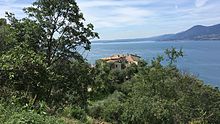Pai (Torri del Benaco)
The village of Pai with approx. 200 inhabitants belongs to the municipality of Torri del Benaco and is located on the eastern shore of Lake Garda , at the foot of Monte Baldo , 6 km north of the main town in the middle of olive groves .
About 1 km north of Pai di sopra is the hamlet of Ca 'Tronconi , which also belongs to Torri del Benaco and has about 14 inhabitants.
description
Antique pile dwellings have been discovered in Pai , which may have given the village its name (it. Palo = pile, pali = piles). The name Palli is already documented in a document from 1184. The variant Pai is only found in a document from the 16th century, a topographical map drawn by Brugnoli - but a document from 1372 is also said to say “Pali sive Pai” . At the beginning of the 20th century "Pai or Pali" was mentioned in some literature.
The place consists of a higher part "Pai di sopra", the fortified village, whose inhabitants used to live from agriculture and cattle breeding, and a part "Pai di sotto" near Lake Garda, where the fishermen lived. It is interesting that in ancient times the upper village was not surrounded by a continuous wall, but rather that each individual group of houses and thus practically each family association formed its own "courtyard". The church dedicated to the Evangelist Mark, the Chiesa San Marco, has been preserved from the oldest part of the village.
history
In the 10th century Berengar I had given permission to build a castle to defend the place against the Hungarians. That castle was destroyed two centuries later when Barbarossa invaded Italy. Today's Chiesa San Marco with a baptismal font from 1522 and a depiction of the Madonna del Rosario (Virgin of the Rosary) from the 15th century on the altar were created through the expansion and enlargement of the chapel, which belonged to the castle destroyed by Barbarossa. The apsidal part of the church was built in 1400, the rest of the building dates from 1703.
In the Pai cemetery there is a small Romanesque church dedicated to San Gregorio Magno. Until 1450 this was the old parish church of Pai. In its interior there are frescoes from the 14th century.
Attractions
- Historic village center of Pai di sopra
- Parish Church of San Marco
- Old washing fountain in Pai di sopra
- Grotta Tanella (only accessible with a guide)
- Well-preserved remains of a lime kiln above Pai di sopra
- Chapel of San Gregorio in the cemetery in Pai di sotto
- Tower on the left side of the former Palazzo Bernini (also called Palazzo Brogi in historical maps and travel guides) in Pai di sotto. The stump of an unfinished tower can be seen on the right. The history of the palazzo and its owner (s) has still not been adequately researched, resp. occupied (as of 2017-06).
- Tibetan bridge. On the hiking trail 41 from Pai di sopra to Crero, a Tibetan-style suspension bridge was inaugurated in August 2019 over the valley section of Val Valzana: span 34.7 m, width 1.44 m, free height above the gorge approx. 42 m
Individual evidence
- ^ Place name Pai
- ↑ Location description
- ^ History
- ↑ La chiesa parrocchiale di San Marco (Italian)
- ↑ La fontana (Italian)
- ↑ Grotta Tanella
- ↑ La calcara (Italian)
- ^ L'oratorio di San Gregorio (Italian)
- ↑ La torre (Italian)
- ↑ Palazzo (Italian)
Web links
- Information about the district of Pai (German)
- Information about Pai (Italian, with photo gallery)
- Tibetan Bridge (video)
Coordinates: 45 ° 39 ' N , 10 ° 43' E


